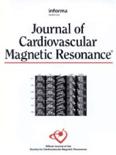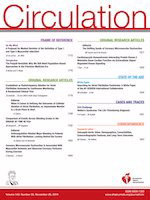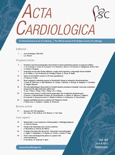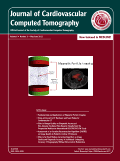
JOURNAL OF CARDIOVASCULAR MAGNETIC RESONANCE
Scope & Guideline
Empowering clinicians and researchers with open access to vital cardiovascular imaging advancements.
Introduction
Aims and Scopes
- Cardiovascular Imaging Techniques:
Focus on the development and application of advanced cardiovascular magnetic resonance imaging techniques, such as 4D flow, T1 and T2 mapping, and late gadolinium enhancement, to enhance diagnostic accuracy and patient outcomes. - Clinical Applications and Outcomes:
Investigation of the clinical implications of cardiovascular magnetic resonance findings, including their prognostic value in various cardiovascular diseases, such as heart failure, myocardial infarction, and congenital heart conditions. - Artificial Intelligence in Imaging:
Exploration of artificial intelligence and machine learning applications in cardiovascular imaging, including automated segmentation, quality assurance, and diagnostic support, aimed at improving efficiency and accuracy in clinical practice. - Innovations in Patient Management:
Research into how cardiovascular magnetic resonance can inform treatment decisions, guide interventions, and monitor disease progression, thereby enhancing patient management strategies. - Multimodal Imaging Approaches:
Integration of cardiovascular magnetic resonance with other imaging modalities and clinical assessments to provide a comprehensive understanding of cardiovascular health and disease.
Trending and Emerging
- Advanced Imaging Techniques:
There is a marked increase in studies utilizing advanced imaging techniques like 4D flow and multiparametric mapping, which provide richer data on hemodynamics and myocardial characteristics. - Artificial Intelligence Applications:
The integration of artificial intelligence in cardiovascular imaging is rapidly gaining traction, with a rise in studies focusing on automated image analysis, predictive modeling, and quality control, aiming to streamline workflows and improve diagnostic accuracy. - Longitudinal and Multimodal Studies:
Emerging interest in longitudinal studies that track cardiovascular changes over time, often integrating multiple imaging modalities to assess disease progression and treatment response. - Patient-Centric Research:
Growing emphasis on research that directly addresses patient outcomes, including quality of life and long-term health impacts, as well as studies focusing on specific populations or conditions, such as those affected by COVID-19. - Interventional Imaging Studies:
Increasing focus on the role of cardiovascular magnetic resonance in guiding interventional procedures and assessing their outcomes, marking a shift towards practical applications in clinical settings.
Declining or Waning
- Basic Research on Imaging Physics:
There has been a gradual decline in papers focusing solely on the fundamental physics of imaging techniques, as the field has shifted towards more clinically applicable research that directly impacts patient care. - Traditional Imaging Techniques:
Publications centered around conventional imaging techniques without the integration of advanced methodologies (e.g., standard echocardiography) are appearing less frequently as newer, more sophisticated techniques gain favor. - Single-Center Studies:
The prevalence of single-center studies is waning, likely due to a growing emphasis on multicenter collaborations that enhance the generalizability and robustness of findings across diverse populations. - Basic Cardiovascular Anatomy Studies:
Research solely focused on anatomical descriptions of cardiovascular structures without functional or clinical implications is becoming less common, as the journal prioritizes studies that elucidate functional outcomes.
Similar Journals

IJC Heart & Vasculature
Shaping the Future of Cardiovascular Medicine TogetherIJC Heart & Vasculature is a premier open-access journal published by Elsevier Ireland Ltd, dedicated to advancing research in the fields of cardiology and cardiovascular medicine. Since its inception in 2013, this journal has established itself as a valuable resource for clinicians, researchers, and students keen on exploring the latest developments in heart and vascular health. With an impressive impact factor and ranked within Q2 in its category (2023), IJC Heart & Vasculature has achieved a significant Scopus rank of #125 out of 387, placing it in the 67th percentile of cardiology journals. The journal not only emphasizes high-quality research but also promotes innovative studies that can shape clinical practices and improve patient outcomes. Researchers and professionals can access a plethora of peer-reviewed articles, original research, and comprehensive reviews that unravel the complexities of cardiovascular science. With a commitment to fostering open and impactful dialogue in the field, IJC Heart & Vasculature is poised to be an essential platform for knowledge exchange in the evolving landscape of cardiovascular research.

Arquivos Brasileiros de Cardiologia
Pioneering open-access research in cardiovascular medicine.Arquivos Brasileiros de Cardiologia is a leading open-access journal dedicated to advancing the field of cardiology and cardiovascular medicine. Established in 1950 and published by the ARQUIVOS BRASILEIROS CARDIOLOGIA, this Brazilian journal plays a crucial role in disseminating high-quality research that addresses both emerging and established topics in cardiovascular science. With an impressive history and a commitment to open access since 1997, it provides researchers, healthcare professionals, and students with free and readily available content that significantly contributes to the understanding and management of cardiovascular diseases. The journal is indexed in Scopus and holds a Q3 ranking in the category of Cardiology and Cardiovascular Medicine, demonstrating its relevance and participation within the global research community. Researchers can submit their work and access a wealth of information that spans a variety of subfields, reflecting the journal’s dedication to fostering innovation and collaboration within cardiology. With a mailing address at Avenida Marechal Câmara, 160-330 Centro, Rio de Janeiro, RJ 20,020-907, Brazil, the journal continues to serve as a vital platform for scholarly communication and knowledge exchange in the cardiovascular realm.

CIRCULATION
Pioneering Research for a Healthier Heart.CIRCULATION is a premier journal in the field of cardiology and cardiovascular medicine, published by Lippincott Williams & Wilkins. With a distinguished history dating back to 1950, the journal has consistently been at the forefront of critical research, showcasing significant advancements and discoveries in cardiovascular health. It holds a remarkable Q1 ranking in both the fields of Cardiology and Physiology (medical) according to the 2023 category quartiles, demonstrating its influential role among the top publications in these disciplines. With an impressive Scopus ranking, placed 3rd out of 387 in Cardiology and 2nd out of 113 in Physiology, CIRCULATION is essential reading for researchers, practitioners, and students passionate about advancing their understanding of heart health and related medical sciences. Although the journal is not open access, it continues to foster scholarly exchange and innovation in cardiovascular research, making it an indispensable resource for quality insights and groundbreaking studies.

ACTA CARDIOLOGICA
Pioneering insights in cardiology and cardiovascular medicine.ACTA CARDIOLOGICA is a distinguished journal published by TAYLOR & FRANCIS LTD, focusing on the dynamic fields of Cardiology and Cardiovascular Medicine. Established in 1946, the journal has maintained a significant presence in the academic community, providing a platform for cutting-edge research and clinical studies that aim to address challenges in cardiovascular health. With its Q3 rating in both Cardiology and General Medicine categories, it showcases a robust compilation of articles that reflect the evolving landscape of cardiac care. Although ACTA CARDIOLOGICA is not an Open Access journal, it continues to serve a vital role for researchers, professionals, and students dedicated to advancing knowledge in cardiovascular health. This journal, with an ISSN of 0001-5385 and E-ISSN of 1784-973X, is a critical resource for those looking to stay updated on the latest developments and practices in the specialization, contributing significantly to the field until 2024 and beyond.

Journal of Cardiovascular Computed Tomography
Connecting experts in the realm of cardiovascular imaging.The Journal of Cardiovascular Computed Tomography, published by Elsevier Science Inc, is a premier international journal dedicated to the field of cardiovascular imaging and technology. With a strong impact factor, it serves as a pivotal platform for disseminating cutting-edge research and advancements from 2007 to 2024, specifically within the realms of cardiology and radiology. The journal holds a distinguished Q1 ranking in both Cardiology and Cardiovascular Medicine and Radiology, Nuclear Medicine and Imaging, reflecting its influential role in shaping clinical and academic discourse in these fields. Notably, the journal boasts impressive Scopus rankings, placing it in the top decile of its categories, highlighting its high-quality publications and significant contribution to the scientific community. Although it does not operate under an open access model, it ensures robust accessibility for researchers, professionals, and students eager to stay informed about the latest innovations and studies in cardiovascular computed tomography. The Journal of Cardiovascular Computed Tomography is essential for anyone involved in cardiovascular research, offering valuable insights and fostering collaborations across disciplines.

MAGNETIC RESONANCE IMAGING
Unveiling the Latest Advances in MRI ApplicationsMAGNETIC RESONANCE IMAGING, published by Elsevier Science Inc, stands at the forefront of research in the fields of Biomedical Engineering, Biophysics, and Radiology, Nuclear Medicine and Imaging. Since its inception in 1982, the journal has become a vital resource, currently enjoying a Q2 ranking in its respective categories as of 2023, underscoring its influence and significance within the scientific community. With an ISSN of 0730-725X and an E-ISSN of 1873-5894, it provides an essential platform for disseminating groundbreaking studies and advancements in magnetic resonance imaging technology and applications. Researchers, professionals, and students benefit from its comprehensive articles that address both theoretical advancements and practical implementation in clinical settings. The journal's commitment to advancing knowledge is reflected in its recognition in Scopus Rankings, where it lies in the 67th percentile for Radiology, Nuclear Medicine and Imaging. By fostering an environment of critical dialogue and innovation, MAGNETIC RESONANCE IMAGING remains a cornerstone publication for those dedicated to pioneering the future of imaging science.

JACC-Cardiovascular Imaging
Elevating Standards in Cardiovascular ResearchJACC-Cardiovascular Imaging, published by Elsevier Science Inc, is a premier journal that focuses on the rapidly evolving field of cardiovascular imaging, providing a vital platform for the dissemination of high-quality research and clinical studies. With an impressive impact factor and ranking within the top tier of cardiology and radiology specialties, the journal is recognized for its commitment to advancing knowledge in diagnostic imaging techniques, including echocardiography, MRI, and CT in cardiovascular contexts. Since its inception in 2008 and converging through 2024, JACC-Cardiovascular Imaging has maintained a distinguished position, currently ranking Q1 both in Cardiology and Cardiovascular Medicine as well as in Radiology, Nuclear Medicine and Imaging. This ensures its relevance and influence, as evidenced by its Scopus rankings—ranked #2 in Radiology and #8 in Cardiology, placing it in the top echelons of scholarly output. Although it does not offer open access, the journal's content is crucial for researchers, clinicians, and students who seek to remain at the forefront of cardiovascular imaging advancements.

JOURNAL OF THORACIC IMAGING
Empowering Clinicians with Cutting-edge Imaging KnowledgeThe JOURNAL OF THORACIC IMAGING, published by Lippincott Williams & Wilkins, stands as a pivotal resource in the fields of Pulmonary and Respiratory Medicine as well as Radiology, Nuclear Medicine, and Imaging. With the ISSN 0883-5993 and E-ISSN 1536-0237, this esteemed journal has been providing critical insights and advancements since its inception in 1985, contributing significantly to the ongoing dialogue and research within these disciplines. The journal maintains a commendable position, ranking in the Q2 category in both relevant fields and achieving an impressive Scopus ranking of #46 out of 333 in Radiology and #30 out of 155 in Pulmonary Medicine, showcasing its influence and impact (with particles in the 86th and 80th percentiles, respectively). While the journal is not open access, it continues to disseminate high-quality research that informs clinical best practices and emerging technologies in thoracic imaging. As a leading publication, it serves as an essential tool for researchers, clinicians, and students seeking to stay at the forefront of thoracic health innovations.

INTERNATIONAL JOURNAL OF CARDIOVASCULAR IMAGING
Pioneering Research in Cardiovascular Medicine and ImagingINTERNATIONAL JOURNAL OF CARDIOVASCULAR IMAGING, published by Springer, is a prestigious platform dedicated to the interdisciplinary field of cardiovascular medicine and imaging. With an ISSN of 1569-5794 and E-ISSN 1875-8312, the journal is recognized in both Cardiology and Cardiovascular Medicine (Rank #154/387, Q2 Category) and Radiology, Nuclear Medicine and Imaging (Rank #137/333, Q2 Category) disciplines, reflecting its significant impact within the scientific community. Established in 1988 and continuing to the present, it provides a rigorous forum for cutting-edge research, reviews, and clinical insights that are essential for advancing knowledge in cardiovascular diagnostics and therapeutic imaging. The journal's dual access options cater to both traditional and open-access readership, ensuring wide dissemination of its findings. In an era where cardiovascular diseases pose a significant public health challenge, the INTERNATIONAL JOURNAL OF CARDIOVASCULAR IMAGING stands out as an essential resource for researchers, healthcare professionals, and scholars aiming to innovate and improve patient outcomes through imaging technology.

JOURNAL OF MAGNETIC RESONANCE IMAGING
Advancing the Frontiers of Magnetic Resonance Imaging.JOURNAL OF MAGNETIC RESONANCE IMAGING (ISSN: 1053-1807; E-ISSN: 1522-2586), published by WILEY, stands as a leading academic platform in the field of Radiology, Nuclear Medicine, and Imaging. With an impressive impact factor that reflects its Q1 ranking in the respective category and a notable Scopus rank of 30 out of 333 journals, this journal serves as a critical resource for cutting-edge research and innovative practices in magnetic resonance imaging. Since its inception in 1991, it has provided a repository of high-quality research, reviews, and clinical applications aimed at enhancing the understanding and technological advancements within the imaging community. Although it does not offer Open Access, the journal's comprehensive approach ensures that professionals, researchers, and students alike can gain crucial insights and contribute significantly to the evolving landscape of medical imaging. With a commitment to excellence and relevance, the journal continues to push the boundaries of knowledge and practice in its field.